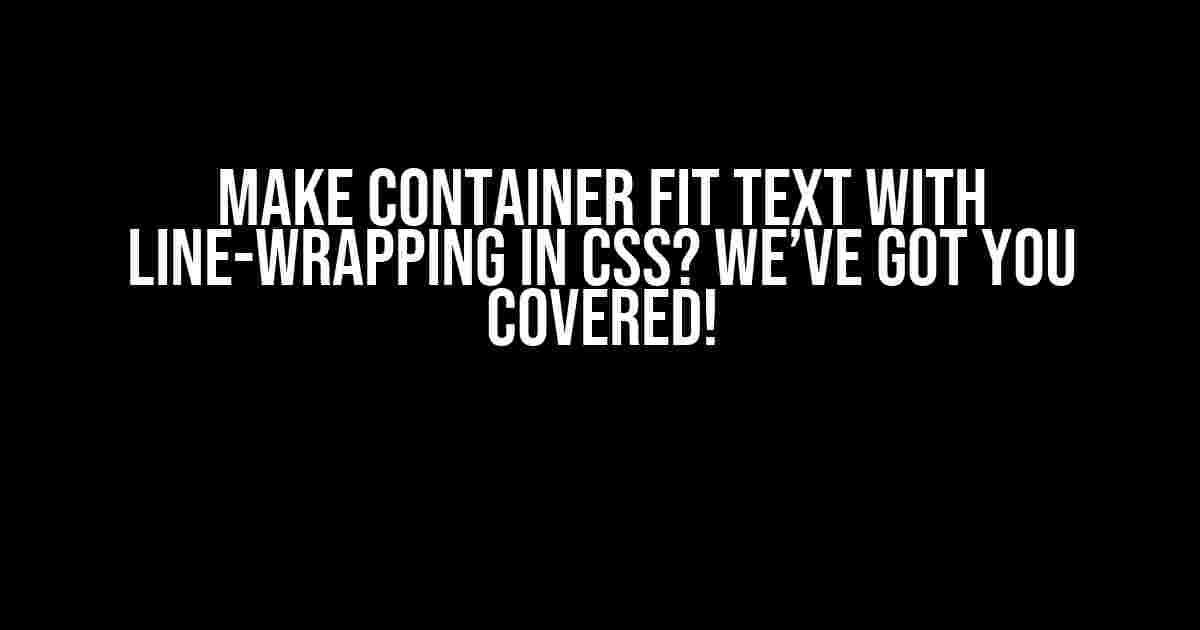Ever struggled with getting your container to snugly fit around your text, only to have it overflow or get chopped off? You’re not alone! In this article, we’ll dive into the world of CSS and explore the magical solutions to make your container fit text with line-wrapping like a pro.
The Problem: Containers Not Fitting Text
We’ve all been there – you’ve got a beautifully crafted paragraph of text, and you want to wrap it in a container that’s just the right size. But, no matter how hard you try, the container either cuts off the text or leaves awkward empty spaces. It’s frustrating, to say the least.
The root of the issue lies in the way CSS handles text wrapping. By default, CSS will only wrap text when it reaches the edge of its container. If the container is too small, the text will overflow or get truncated. But fear not, dear reader, for we’ve got the solutions you need!
Method 1: Using the `word-wrap` Property
One of the simplest ways to get your container to fit text with line-wrapping is by using the `word-wrap` property. This property allows you to specify how the text should behave when it reaches the edge of the container.
.container {
width: 200px; /* Set the width of the container */
word-wrap: break-word; /* Allow the text to wrap to the next line */
}
In the above example, we’ve set the width of the container to 200 pixels and enabled `word-wrap` with the value `break-word`. This tells the browser to break the text into multiple lines when it reaches the edge of the container.
Method 2: Using the `white-space` Property
Another approach to achieving the desired effect is by using the `white-space` property. This property controls how whitespace characters (like spaces, tabs, and line breaks) are handled within the container.
.container {
width: 200px; /* Set the width of the container */
white-space: normal; /* Allow the text to wrap to the next line */
}
In this example, we’ve set the `white-space` property to `normal`, which allows the browser to wrap the text to the next line when it reaches the edge of the container.
Method 3: Using Flexbox
If you’re working with a more complex layout, Flexbox might be the way to go. By using the `flex-wrap` property, you can get your container to fit text with line-wrapping.
.container {
display: flex; /* Enable Flexbox */
flex-wrap: wrap; /* Allow the text to wrap to the next line */
width: 200px; /* Set the width of the container */
}
In this example, we’ve enabled Flexbox by setting `display` to `flex`, and then enabled text wrapping by setting `flex-wrap` to `wrap`. Finally, we’ve set the width of the container to 200 pixels.
Additional Tips and Tricks
While the above methods will get you most of the way there, there are a few additional tips and tricks to keep in mind:
- Use `max-width` instead of `width`: If you want your container to shrink to fit the text, use `max-width` instead of `width`. This will ensure that the container adapts to the text’s size.
- Add padding for breathing room: Adding padding to your container can help create a more visually appealing design. Just be sure to adjust the width accordingly to avoid overflow.
- Use `box-sizing` for accurate sizing: The `box-sizing` property can help you achieve more accurate calculations for your container’s size. Set it to `border-box` to include padding and borders in the width calculation.
Common Pitfalls to Avoid
Even with the above methods, you might still run into some common pitfalls. Here are a few to watch out for:
- Not setting a width or max-width: Failing to set a width or max-width can cause your container to take up the full width of its parent element, leading to unwanted text wrapping.
- Not accounting for padding and borders: Forgetting to account for padding and borders can cause your container to overflow or cut off the text.
- Using the wrong display type: Using the wrong display type (e.g., `display: inline` instead of `display: block`) can prevent the container from wrapping the text correctly.
Conclusion
In conclusion, making a container fit text with line-wrapping in CSS is a cinch! By using the `word-wrap`, `white-space`, or Flexbox methods, you can achieve the perfect fit for your text. Remember to keep an eye out for common pitfalls and take advantage of additional tips and tricks to create a beautiful, responsive design.
| Method | Property | Description |
|---|---|---|
| Method 1: `word-wrap` | `word-wrap: break-word` | Allows text to wrap to the next line when it reaches the edge of the container |
| Method 2: `white-space` | `white-space: normal` | Allows text to wrap to the next line when it reaches the edge of the container |
| Method 3: Flexbox | `display: flex; flex-wrap: wrap` | Enables Flexbox and allows text to wrap to the next line when it reaches the edge of the container |
Now that you’ve mastered the art of making containers fit text with line-wrapping, go forth and create stunning designs that delight your users!
Happy coding, and don’t forget to share your creations with us on social media using the hashtag #CSSmagic!
Here is the HTML code with 5 questions and answers about “Make container fit text with line-wrapping in CSS”:
Frequently Asked Questions
Get the answers to your most pressing questions about making containers fit text with line-wrapping in CSS!
How do I make a container fit the text with line-wrapping in CSS?
You can make a container fit the text with line-wrapping by setting the `width` property to a specific value, and then using the `word-wrap` property set to `break-word`. This will allow the text to wrap to the next line when it reaches the edge of the container.
What is the difference between `word-wrap` and `word-break` in CSS?
`word-wrap` is used to break a long word into multiple lines, while `word-break` is used to specify how to break a line of text. `word-wrap` is more commonly used to make a container fit text with line-wrapping.
How do I make a container fit text with multiple lines in CSS?
You can make a container fit text with multiple lines by setting the `height` property to `auto`, and then using the `overflow-y` property set to `auto`. This will allow the container to expand vertically to fit the text.
Can I use flexbox to make a container fit text with line-wrapping in CSS?
Yes, you can use flexbox to make a container fit text with line-wrapping by setting the `display` property to `flex`, and then using the `flex-wrap` property set to `wrap`. This will allow the text to wrap to the next line when it reaches the edge of the container.
What is the best way to make a container fit text with line-wrapping in CSS for responsive design?
The best way to make a container fit text with line-wrapping in CSS for responsive design is to use relative units such as `%`, `em`, or `rem` for the `width` and `height` properties, and then use media queries to adjust the container’s dimensions based on different screen sizes.



